Hold down the T key for 3 seconds to activate the audio accessibility mode, at which point you can click the K key to pause and resume audio. Useful for the Check Your Understanding and See Answers.
Like the force of gravity and the electrostatic force, magnets apply forces at a distance. In other words, one magnet does not need to touch another magnet to feel its presence. Scientists make sense of this ‘force at a distance’ by attributing it to the existence of an invisible field that surrounds the magnet. We’ll call this a magnetic field.
While magnetic fields are invisible to us, if we sprinkle iron filing around a bar magnet, we see that magnetic fields appear to be very real.
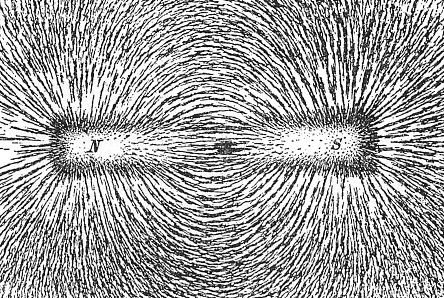
Figure 1
Physicists often visualize magnetic fields using magnetic field lines. Magnetic field lines are ‘lines of force.’ They communicate two things about the magnetic field in the region around the magnet: its strength and its direction.
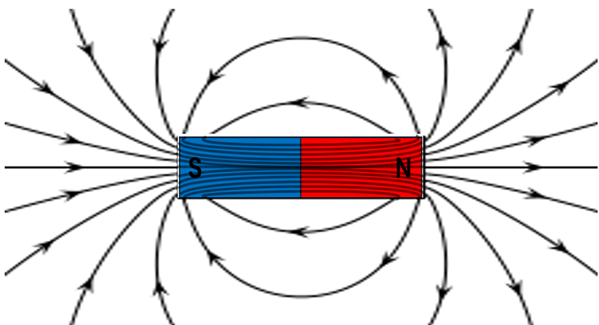
Strength of Field
The strength of the magnetic field is shown by the density of lines. Where the field is strong, magnetic field lines are densely packed. Where the field is weak, there is a great deal of space between adjacent lines.
Direction of Field
The direction of the magnetic field is defined as the direction that the north end of a compass needle will point. Magnetic field lines point away from north poles and toward south poles because that’s what the north end of a compass will do.
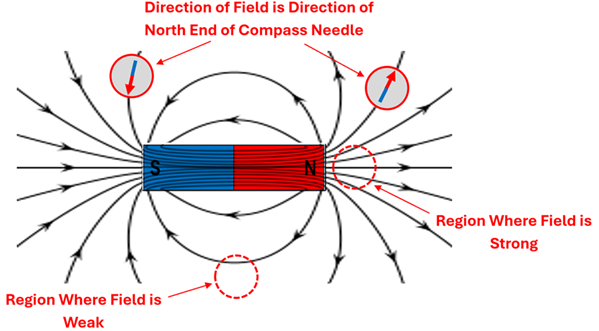
A compass is the tool that sailors, physicists…actually everyone! use to find the direction of the magnetic field at any point in space. A compass is simply a tiny magnet suspended so it can easily pivot. It makes sense that the north end of this tiny magnet would align with the magnetic field since it is merely repelling nearby north poles and attracting nearby south poles.
If you are having an inkling that a magnetic field is a vector, you’re right! We saw back in Lesson 1 of 1-D Kinematics that vectors are quantities that have both a magnitude and direction. Magnetic fields have both.
We will measure magnetic field strength in units called Tesla (T), named after Nikola Tesla, a Serbian-American inventor who pioneered alternating current (AC), wireless transmission, remote control, and hydro-electric power plants. We’ll see in the chapter on Electromagnetic Induction that all of these inventions rely on magnetic fields!
Field Near Multiple Bar Magnets and a Horseshoe Magnet
Magnets can be configured in different arrangements to produce magnetic fields of different shapes. As we will see in Lesson 3: Magnetism and Moving Charges, this can be useful to steer moving charges. Notice that the shape of the field lines between two opposite poles and that between two same poles is remarkably similar to that of the electric field lines between two opposite and same charges. You may also notice that a horseshoe magnet is simply a “U-shaped” bar magnet. This is useful when creating a uniform magnet field is desired--just like two parallel, oppositely charged plates can be used to create a uniform electric field.

We’re continuing to uncover striking similarities between electricity and magnetism. Like scientists of the past, you may be asking the question, "Is there a connection between these two phenomena?" This is the very question we’ll explore in greater detail on the next page of this lesson and throughout the rest of this chapter.
Magnetic Field of the Earth
Since the Earth itself has a north and south pole, does the Earth have a magnet inside of it? Scientists believe that the Earth's magnetic field is caused by the movement of molten iron in the Earth's liquid outer core. This moving iron generates electric currents that in turn create the Earth’s magnetic field. Nonetheless, the Earth’s magnetic field can be approximated as if a bar magnet runs along its axis of rotation. However, since the north end of a compass needle points to the north geographic pole, this means that the north geographic pole is actually a magnetic south pole. Similarly, while Antarctica covers the south geographic pole, that is where the magnetic north pole of the Earth resides!
Nomadic people from the Middle East were the first to use the compass rose to mark the direction of the rising and setting of stars in the sky. This way they could describe directions other than just north and south.
We Would Like to Suggest ...
 Why just read about it and when you could be interacting with it? Interact - that's exactly what you do when you use one of The Physics Classroom's Interactives. We would like to suggest that you combine the reading of this page with the use of our Magnetic Fields interactive to explore the field around a single magnet and the Bar Magnets interactive to visualize the field around a configuration of several magnets. You can find it in the Physics Interactives section of our website.
Why just read about it and when you could be interacting with it? Interact - that's exactly what you do when you use one of The Physics Classroom's Interactives. We would like to suggest that you combine the reading of this page with the use of our Magnetic Fields interactive to explore the field around a single magnet and the Bar Magnets interactive to visualize the field around a configuration of several magnets. You can find it in the Physics Interactives section of our website.
Visit: Magnetic Fields and Bar Magnets
Check Your Understanding
Use the following questions to assess your understanding. Tap the Check Answer buttons when ready.
1. What is the direction of the magnetic field of this bar magnet at each location?

2. Rank the strength (from strongest to weakest) of this bar magnet’s magnetic field at each of these locations.
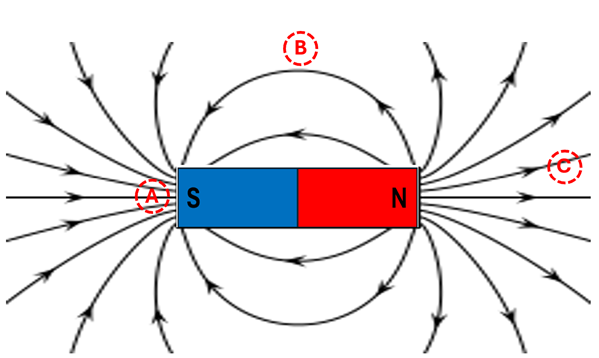
3. Identify the polarity (north or south) of each pole for these field configuration.
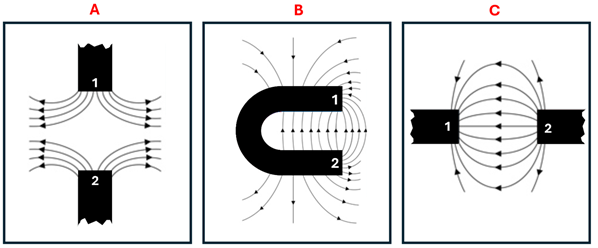
4. Which of these four fields best illustrates a magnetic field that is uniform and strong?
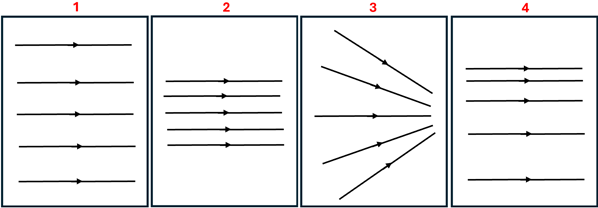
5. While hiking along a path, you notice that the red end (north end) of your compass points in the direction shown. For each situation, determine the direction you are walking?
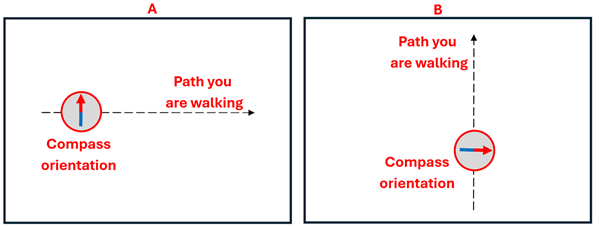
6. True or False: The geographic north pole of the Earth is actually a magnetic south pole?
Figure 1 Source: https://commons.wikimedia.org/wiki/File:Magnet0873.jpg
Figure 2 Source: https://commons.wikimedia.org/wiki/File:Compass_Rose_English_North.svg